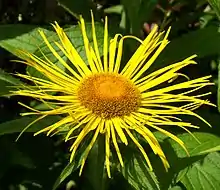| Inula hookeri | |
|---|---|
 | |
| Scientific classification | |
| Kingdom: | Plantae |
| Clade: | Tracheophytes |
| Clade: | Angiosperms |
| Clade: | Eudicots |
| Clade: | Asterids |
| Order: | Asterales |
| Family: | Asteraceae |
| Genus: | Inula |
| Species: | I. hookeri |
| Binomial name | |
| Inula hookeri | |
Inula hookeri, Hooker's inula or Hooker's fleabane,[1] is a species of flowering plant in the sunflower and daisy family Asteraceae. It is a native of the Himalayas (Bhutan and Nepal), India (Sikkim), Myanmar and China (SE Xizang, NW Yunnan), where it grows in a variety of open habitats at 2,400–3,600 m (7,900–11,800 ft).[2]
The specific epithet hookeri commemorates the plant hunter Sir Joseph Hooker, who brought it back from the Himalayas to Britain in 1849.[3]
Description
This herbaceous perennial is a tall stemmed plant growing to 75 cm (30 in), with 2 or 3 flower heads per plant. The flowers, which may be up to 8 cm (3.1 in) in diameter, appear in late summer and autumn. Each inflorescence comprises a disc of many needle-like yellow ray florets surrounding a raised central boss of deeper yellow disc florets.[4]
References
- ↑ "Inula hookeri". Germplasm Resources Information Network. Agricultural Research Service, United States Department of Agriculture.
- ↑ "Inula hookeri". Flora of China – via eFloras.org, Missouri Botanical Garden, St. Louis, MO & Harvard University Herbaria, Cambridge, MA.
- ↑ "Inula hookeri: Plant of the Month; January". Birmingham Botanical Gardens (United Kingdom). Retrieved 28 September 2021.
- ↑ "Inula hookeri". RHS. Retrieved 7 September 2021.